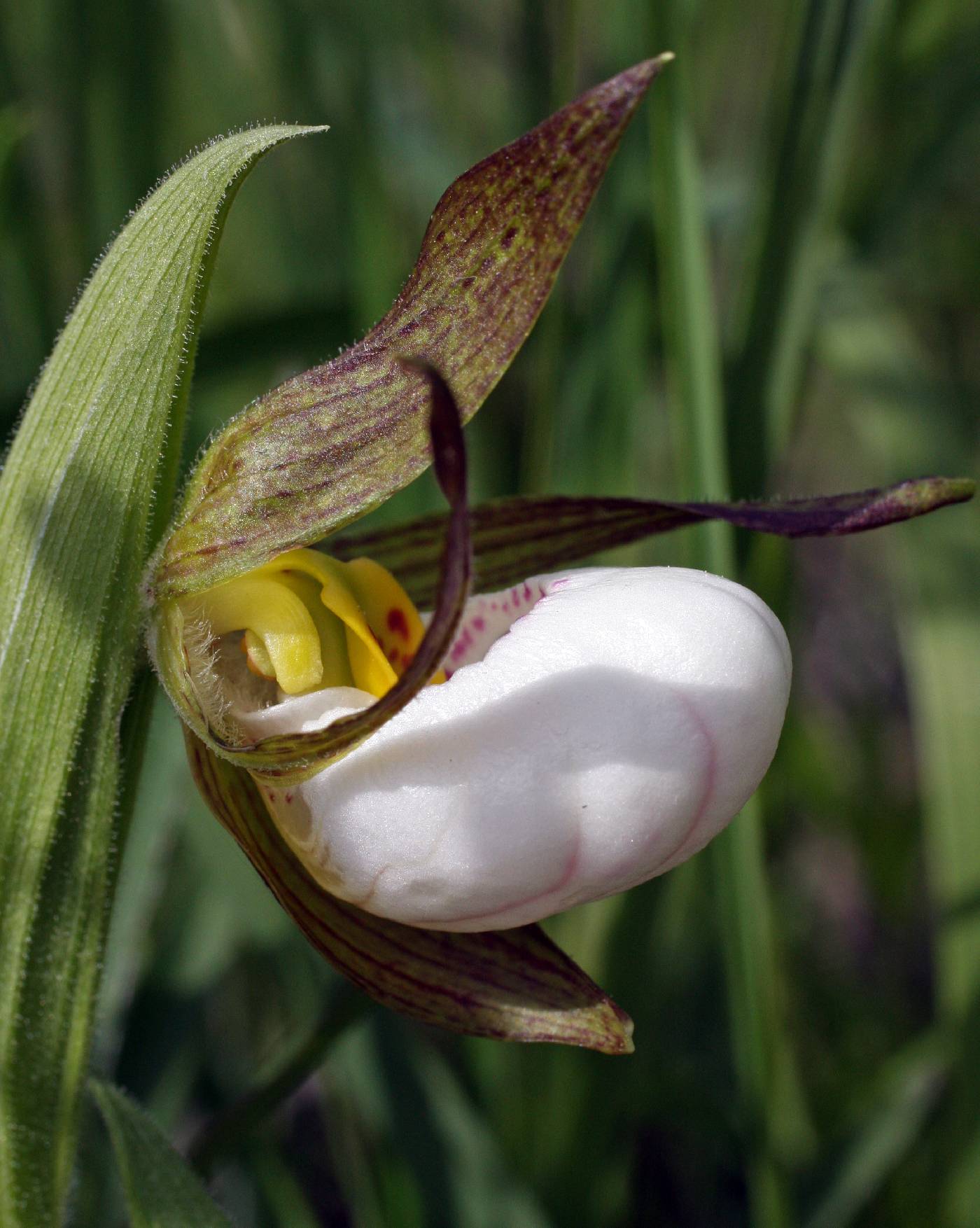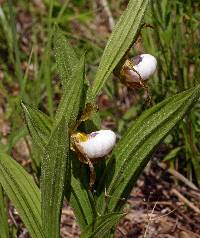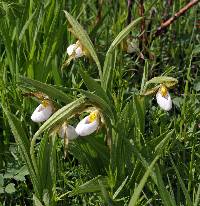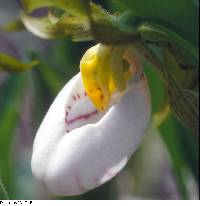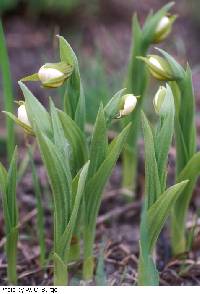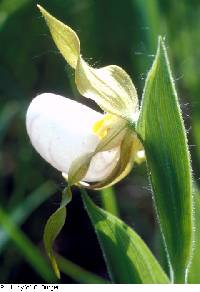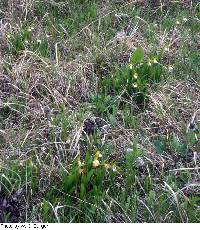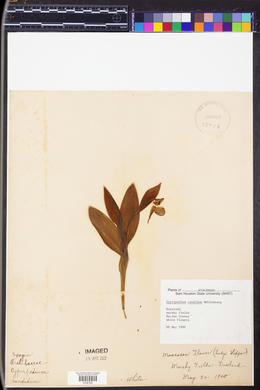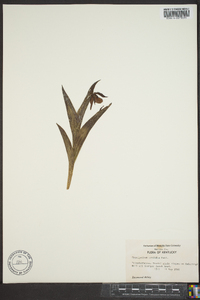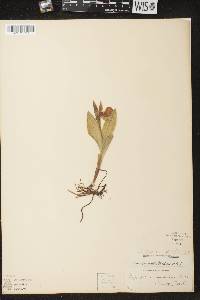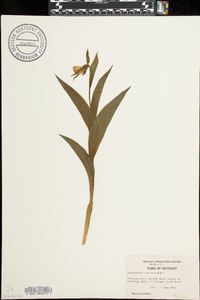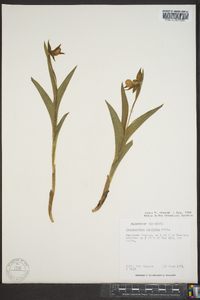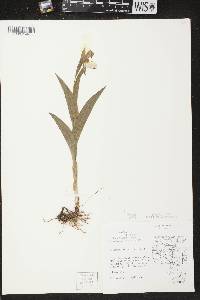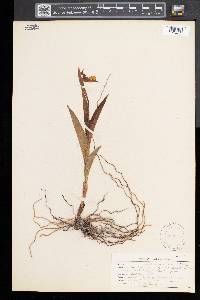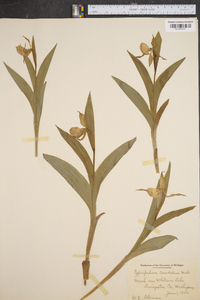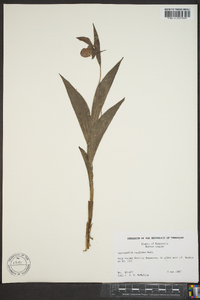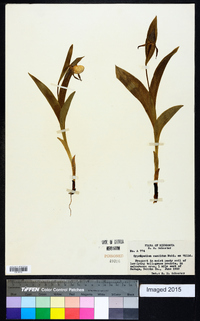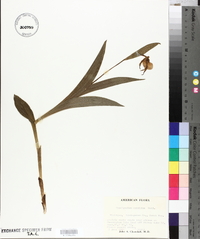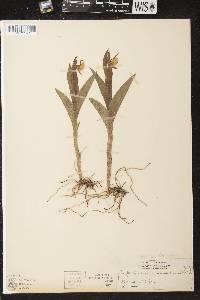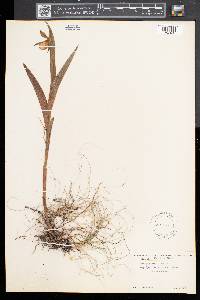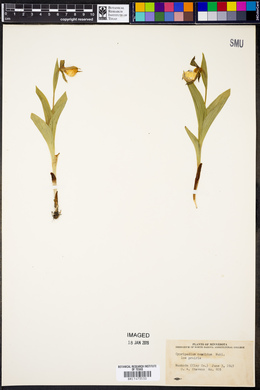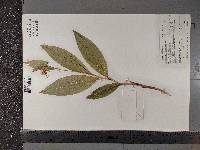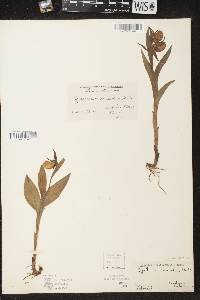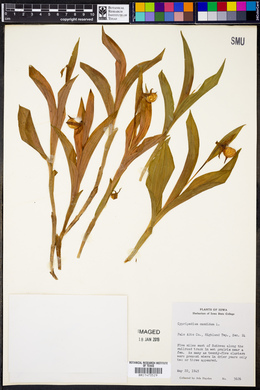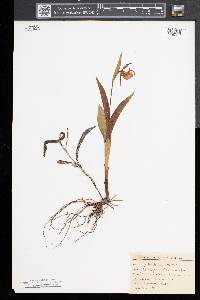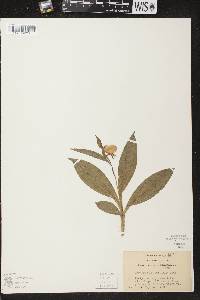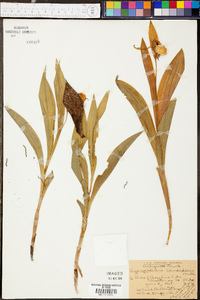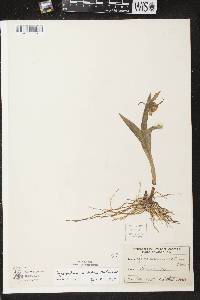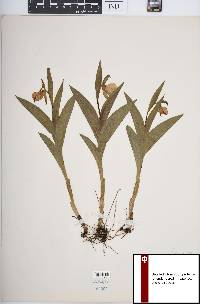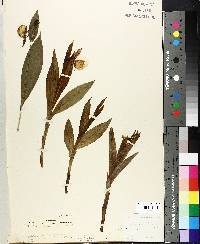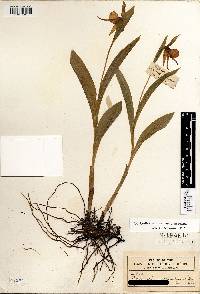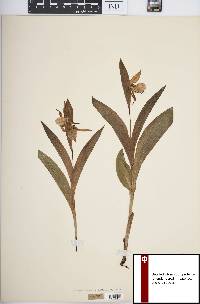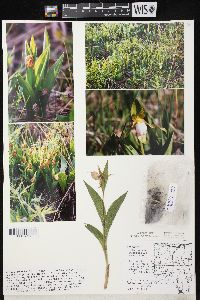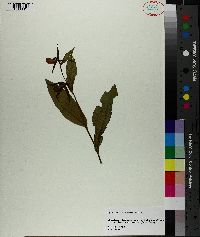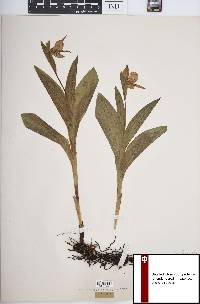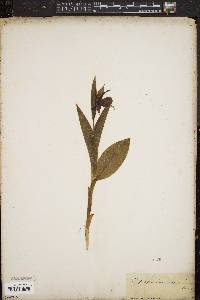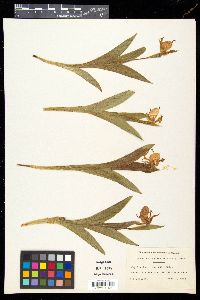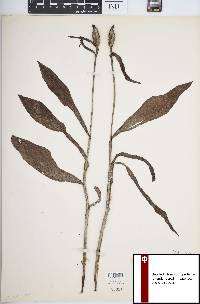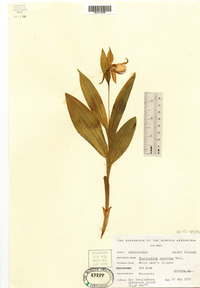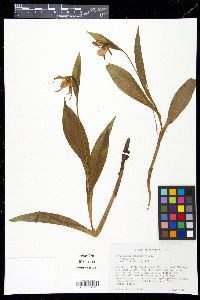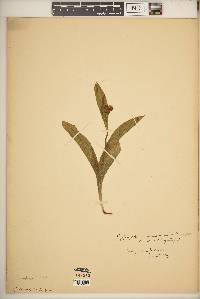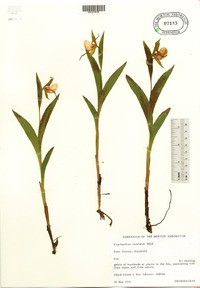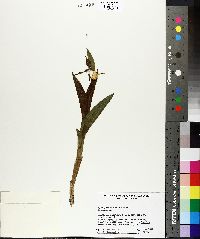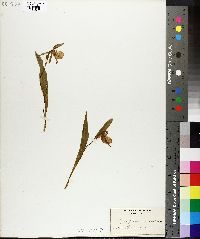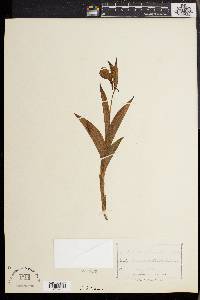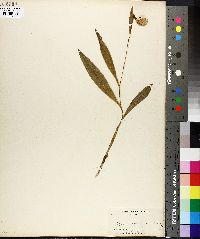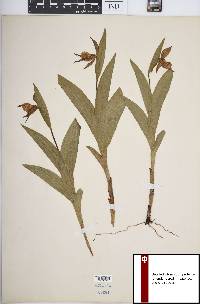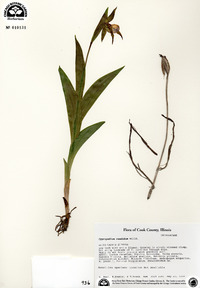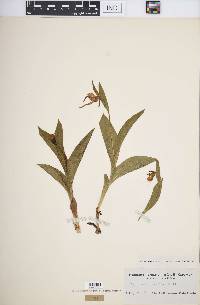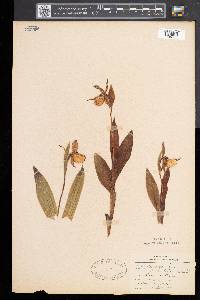Cypripedium candidum
|
|
|
|
Family: Orchidaceae
Small White Lady's-Slipper, more...white lady
|
Plants erect, 11-40 cm. Leaves 3-4(-5), on proximal or middle portion of stem, alternate, erect-ascending; blade lanceolate or elliptic to oblanceolate, 7-20 × 0.9-5.3 cm. Flowers 1(-2); sepals green to pale brownish yellow, usually spotted and striped with reddish brown or madder; dorsal sepal ovate to ovate-lance-acuminate, 15-35 × 7-13 mm; lateral sepals connate; synsepal 13-35 × 7-15 mm; petals spreading to somewhat deflexed, same color as sepals, spirally twisted or spiral-undulate, lanceolate to linear-lanceolate, 23-46 × 3-5 mm; lip white, obovoid or oblance-ovoid to oblance-fusiform, 17-27 mm; orifice basal, 10-15 mm; staminode lanceoloid or oblong-lanceoloid to ellipsoid. 2n = 20. Flowering Apr--Jul. Mesic to wet prairies and fen meadows, very rarely open wooded slopes; 70--700 m; Man., Ont., Sask.; Ala., Ill., Ind., Iowa., Ky., Md., Mich., Minn., Mo., Nebr., N.J., N.Y., N.Dak., Ohio, Pa., S.Dak., Wis. Cypripedium candidum begins blooming while the shoots are still emerging from the soil; at that time they are small, with the leaves clustered near the base. The plants enlarge greatly during and after anthesis, and the leaves may assume a more median position. The orifice of the lip in C. candidum is distinctive, the apical margin forming an acute angle. This feature is shared with C. montanum and differs from the commonly obtuse margin in C. parviflorum; hence, it can aid determination of discolored herbarium specimens. Hybrids of C. candidum and C. parviflorum have been designated C. × andrewsii A. M. Fuller. See 11. C. parviflorum for a general discussion of hybridization and variation within and between related species.
Perennial herb 10 - 40 cm tall Stem: one, erect, dainty, relatively short (typically about 20 cm), green, leafy, hairy. Leaves: three to five, alternate, erect-ascending, stalkless, sheathing, green, 7 - 20 cm long, 0.9 - 5.3 cm wide, elliptic to lance-shaped, non-toothed, folded lengthwise, strongly ribbed, and hairy. Inflorescence: usually of one (rarely two), erect, terminal, stalked flower closely subtended by a stalkless, erect, green, hairy, leaf-like, 5 - 7 cm long, 1.5 - 2 cm wide, lance-shaped bract ensheathing flower stalk. The plant begins blooming while the shoot is still emerging from the soil so in addition from being small overall, the leaves are typically clustered at the base of the stem, flowers often emerge from still uncurling and sheathing leaves, and as it matures the leaves become more spaced through the middle of the stem. Sepals: three, but two lower fused together (except notch at tip) into synsepal positioned behind and below lip petal, with single upper, central, egg-shaped to wide lance-shaped, tapering, pointed-tipped sepal above inflated lip petal. Both the synsepal and upper (dorsal) sepal are 1.3 - 3.5 cm long, 0.7 - 1.5 cm wide, hairy, and green to pale brown-yellow with reddish brown spots or stripes. Fruit: one, stalked, erect, widely ellipsoid, hairy capsule with remnant reproductive parts at tip, raised lengthwise ridges, and subtended by remnant hairy bract. Root system: of slender, fleshy, fibrous true roots arising from rhizomes. Flower: white, showy, hairy, bilaterally symmetric with highly modified, very inflated, egg-shaped lip petal, and producing a delicate, intoxicating fragrance. Unlike other orchids, the reproductive parts of stamens and stigma are not fused into a column above the inferior ovary, but instead at the basal opening of the lip petal there are two separate anthers, one large, sterile, modified staminode, and a lobed stigma above the hairy inferior ovary. Lateral petals: two, spreading to somewhat deflexed, green to pale brown-yellow with reddish brown spots or stripes, hairy, 2.3 - 4.6 cm long, 3 - 8 mm wide, loosely spirally twisted, lance-shaped to more linear. Lip petal: one, central, lowermost, predominantly waxy white, 1.5 - 3.3 cm long, about 1 - 1.3 cm wide, greatly inflated, pouch-like, egg-shaped, and hairy. On the inner surface of the pouch the veins are colored dark purple, which is faintly visible on the outside especially along the bottom, and there is also purple spotting surrounding and inside the basal opening (orifice) of the petal. Basal orifice 1 - 1.5 cm diameter with outer edge (opposite staminode) forming somewhat pointed, acute angle. Staminode: one, prominent, yellow with purple spots, oblong to ellipsoid or broadly lance-shaped, and positioned below upper sepal and pointing down to basal opening (orifice) of lip. On the back side of the staminode the two anthers are positioned on each side of the central lobed stigma. Similar species: Cypripedium candidum is most similar to C. x andrewsii, its hybrid with C. parviflorum, but the hybrid typically has different colored flowers: either an ivory-white lip with dark maroon sepals and lateral petals, or a pale cream lip (fading to yellowish) with longer greenish sepals streaked with brown, and more tightly spiraled lateral petals. Cypripedium parviflorum and its varieties differ by having yellow lip petals, and the lip's basal opening (orifice) has a widely rounded, obtuse angle along the outer edge (opposite the staminode). Flowering: April to June Habitat and ecology: Very rare now, many previous populations extirpated; requires moist, organic, calcareous soils and open sun exposure; typically found in mesic to wet prairies, fens, limy thickets, sedge meadows, or marsh. This species is very sun-loving, it does not tolerate shade, and also does poorly in areas with even moderate disturbance, which means conservation of this orchid requires management work to remove woody species to inhibit shading and disturbance in the form of invading. Occurence in the Chicago region: native Notes: The white lady's slipper orchid is much rarer in our area than it used to be primarily due to the widespread destruction of prairies. Etymology: Cypripedium comes from combining the Greek word Kypris for Cypris (Aphrodite), the goddess of love and beauty; and either the Latin word pedis meaning foot, or possibly an orthrographic error for the Greek word pedilon meaning sandal or slipper; together translating roughly to beauty's or lady's foot or slipper, in reference to the inflated lip petal resembling a woman's slipper or shoe. Candidum means white in reference to the predominantly white flowers. Author: The Field Museum Stem 1.5-4 dm, with a few sheathing scales below and 3-5 lvs; lf-blades lanceolate to narrowly elliptic, often overlapping at base, 8-15 cm, the uppermost smaller, erect, and subtending the solitary fl; sep and lateral pet lance-linear, greenish, often red-striped, 2-4 cm, the pet often closely twisted; lip white, veined with violet within, 1.5-2.5 cm; 2n=20. In calcareous soils of marly bogs, open swamps, and wet prairies; N.Y. and N.J. to O., N.D., Nebr., and Mo. May, June. A hybrid with no. 4 [Cypripedium calceolus L.] is C. ءndrewsii A. M. Fuller. Gleason, Henry A. & Cronquist, Arthur J. 1991. Manual of vascular plants of northeastern United States and adjacent Canada. lxxv + 910 pp. ©The New York Botanical Garden. All rights reserved. Used by permission. From Flora of Indiana (1940) by Charles C. Deam This species is very local and I now know of only six places in the state where it occurs. There are no reports for it in Indiana outside of the range indicated on the map except that Schneck in 1876 reported it as occurring in the Lower Wabash Valley, saying: "Rapidly disappearing, once common here." I was informed by a reliable authority that it has been found in two places on springy banks in Tippecanoe County. It is generally found on "raised springy areas" and usually associated with Zizia area. It occurs in Porter County in a cattail mucky area. |
|
|
|

